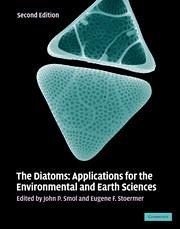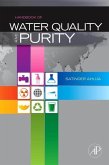The Diatoms
Herausgeber: Smol, John P; Stoermer, Eugene F
The Diatoms
Herausgeber: Smol, John P; Stoermer, Eugene F
- Gebundenes Buch
- Merkliste
- Auf die Merkliste
- Bewerten Bewerten
- Teilen
- Produkt teilen
- Produkterinnerung
- Produkterinnerung
A much revised and greatly extended compilation of the expanding uses of diatoms in the environmental and earth sciences.
Andere Kunden interessierten sich auch für
![Handbook of Water Purity and Quality Handbook of Water Purity and Quality]() Handbook of Water Purity and Quality262,99 €
Handbook of Water Purity and Quality262,99 €![Parasites, People, and Places Parasites, People, and Places]() Gerald W EschParasites, People, and Places126,99 €
Gerald W EschParasites, People, and Places126,99 €![Conservation for the Anthropocene Ocean Conservation for the Anthropocene Ocean]() Conservation for the Anthropocene Ocean69,99 €
Conservation for the Anthropocene Ocean69,99 €![Living with the Earth, Fourth Edition Living with the Earth, Fourth Edition]() Gary S MooreLiving with the Earth, Fourth Edition126,99 €
Gary S MooreLiving with the Earth, Fourth Edition126,99 €![Monkeys of the Taï Forest Monkeys of the Taï Forest]() W. Scott McGraw / Klaus Zuberbühler / Ronald Noë (eds.)Monkeys of the Taï Forest146,99 €
W. Scott McGraw / Klaus Zuberbühler / Ronald Noë (eds.)Monkeys of the Taï Forest146,99 €![In Search of the Canary Tree In Search of the Canary Tree]() Lauren E OakesIn Search of the Canary Tree23,99 €
Lauren E OakesIn Search of the Canary Tree23,99 €![Environmental Cardiology Environmental Cardiology]() Environmental Cardiology179,99 €
Environmental Cardiology179,99 €-
-
-
A much revised and greatly extended compilation of the expanding uses of diatoms in the environmental and earth sciences.
Hinweis: Dieser Artikel kann nur an eine deutsche Lieferadresse ausgeliefert werden.
Hinweis: Dieser Artikel kann nur an eine deutsche Lieferadresse ausgeliefert werden.
Produktdetails
- Produktdetails
- Verlag: Cambridge University Press
- 2nd edition
- Seitenzahl: 686
- Erscheinungstermin: 8. November 2010
- Englisch
- Abmessung: 283mm x 230mm x 40mm
- Gewicht: 2086g
- ISBN-13: 9780521509961
- ISBN-10: 0521509963
- Artikelnr.: 29934606
- Herstellerkennzeichnung
- Libri GmbH
- Europaallee 1
- 36244 Bad Hersfeld
- gpsr@libri.de
- Verlag: Cambridge University Press
- 2nd edition
- Seitenzahl: 686
- Erscheinungstermin: 8. November 2010
- Englisch
- Abmessung: 283mm x 230mm x 40mm
- Gewicht: 2086g
- ISBN-13: 9780521509961
- ISBN-10: 0521509963
- Artikelnr.: 29934606
- Herstellerkennzeichnung
- Libri GmbH
- Europaallee 1
- 36244 Bad Hersfeld
- gpsr@libri.de
Preface
Part I. Introduction: 1. Applications and uses of diatoms: prologue
2. The diatoms: a primer
3. Numerical methods for the analysis of diatom assemblage data
Part II. Diatoms as Indicators of Environmental Change in Flowing Waters and Lakes: 4. Assessing environmental conditions in rivers and streams with diatoms
5. Diatoms as indicators of long-term environmental change in rivers, fluvial lakes and impoundments
6. Diatoms as indicators of surface-water acidity
7. Diatoms as indicators of lake eutrophication
8. Diatoms as indicators of environmental change in shallow lakes
9. Diatoms as indicators of water-level change in freshwater lakes
10. Diatoms as indicators of hydrologic and climatic change in saline lakes
11. Diatoms in ancient lakes
Part III. Diatoms as Indicators in Arctic, Antarctic and Alpine Lacustrine Environments: 12. Diatoms as indicators of environmental change in subarctic and alpine regions
13. Freshwater diatoms as indicators of environmental change in the High Arctic
14. Diatoms as indicators of environmental change in Antarctic and subantarctic freshwaters
Part IV. Diatoms as Indicators in Marine and Estuarine Environments: 15. Diatoms and environmental change in large brackish-water ecosystems
16. Applied diatom studies in estuaries and shallow coastal environments
17. Estuarine paleoenvironmental reconstructions using diatoms
18. Diatoms on coral reefs and in tropical marine lakes
19. Diatoms as indicators of former sea levels, earthquakes, tsunamis and hurricanes
20. Marine diatoms as indicators of modern changes in oceanographic conditions
21. Holocene marine diatom records of environmental change
22. Diatoms as indicators of paleoceanographic events
23. Reconsidering the meaning of biogenic silica accumulation rates in the glacial Southern Ocean
Part V. Other Applications: 24. Diatoms of aerial habitats
25. Diatoms as indicators of environmental change in wetlands and peatlands
26. Tracking fish, seabirds, and wildlife population dynamics with diatoms and other limnological indicators
27. Diatoms and archaeology
28. Diatoms in oil and gas exploration
29. Forensic science and diatoms
30. Toxic marine diatoms
31. Diatoms as markers of atmospheric transport
32. Diatoms as nonnative species
33. Diatomite
34. Stable isotopes from diatom silica
35. Diatoms and nanotechnology: early history and imagined future as seen through patents
Part VI. Conclusions: 36. Epilogue: a view to the future
Glossary, acronyms, and abbreviations
Index.
Part I. Introduction: 1. Applications and uses of diatoms: prologue
2. The diatoms: a primer
3. Numerical methods for the analysis of diatom assemblage data
Part II. Diatoms as Indicators of Environmental Change in Flowing Waters and Lakes: 4. Assessing environmental conditions in rivers and streams with diatoms
5. Diatoms as indicators of long-term environmental change in rivers, fluvial lakes and impoundments
6. Diatoms as indicators of surface-water acidity
7. Diatoms as indicators of lake eutrophication
8. Diatoms as indicators of environmental change in shallow lakes
9. Diatoms as indicators of water-level change in freshwater lakes
10. Diatoms as indicators of hydrologic and climatic change in saline lakes
11. Diatoms in ancient lakes
Part III. Diatoms as Indicators in Arctic, Antarctic and Alpine Lacustrine Environments: 12. Diatoms as indicators of environmental change in subarctic and alpine regions
13. Freshwater diatoms as indicators of environmental change in the High Arctic
14. Diatoms as indicators of environmental change in Antarctic and subantarctic freshwaters
Part IV. Diatoms as Indicators in Marine and Estuarine Environments: 15. Diatoms and environmental change in large brackish-water ecosystems
16. Applied diatom studies in estuaries and shallow coastal environments
17. Estuarine paleoenvironmental reconstructions using diatoms
18. Diatoms on coral reefs and in tropical marine lakes
19. Diatoms as indicators of former sea levels, earthquakes, tsunamis and hurricanes
20. Marine diatoms as indicators of modern changes in oceanographic conditions
21. Holocene marine diatom records of environmental change
22. Diatoms as indicators of paleoceanographic events
23. Reconsidering the meaning of biogenic silica accumulation rates in the glacial Southern Ocean
Part V. Other Applications: 24. Diatoms of aerial habitats
25. Diatoms as indicators of environmental change in wetlands and peatlands
26. Tracking fish, seabirds, and wildlife population dynamics with diatoms and other limnological indicators
27. Diatoms and archaeology
28. Diatoms in oil and gas exploration
29. Forensic science and diatoms
30. Toxic marine diatoms
31. Diatoms as markers of atmospheric transport
32. Diatoms as nonnative species
33. Diatomite
34. Stable isotopes from diatom silica
35. Diatoms and nanotechnology: early history and imagined future as seen through patents
Part VI. Conclusions: 36. Epilogue: a view to the future
Glossary, acronyms, and abbreviations
Index.
Preface
Part I. Introduction: 1. Applications and uses of diatoms: prologue
2. The diatoms: a primer
3. Numerical methods for the analysis of diatom assemblage data
Part II. Diatoms as Indicators of Environmental Change in Flowing Waters and Lakes: 4. Assessing environmental conditions in rivers and streams with diatoms
5. Diatoms as indicators of long-term environmental change in rivers, fluvial lakes and impoundments
6. Diatoms as indicators of surface-water acidity
7. Diatoms as indicators of lake eutrophication
8. Diatoms as indicators of environmental change in shallow lakes
9. Diatoms as indicators of water-level change in freshwater lakes
10. Diatoms as indicators of hydrologic and climatic change in saline lakes
11. Diatoms in ancient lakes
Part III. Diatoms as Indicators in Arctic, Antarctic and Alpine Lacustrine Environments: 12. Diatoms as indicators of environmental change in subarctic and alpine regions
13. Freshwater diatoms as indicators of environmental change in the High Arctic
14. Diatoms as indicators of environmental change in Antarctic and subantarctic freshwaters
Part IV. Diatoms as Indicators in Marine and Estuarine Environments: 15. Diatoms and environmental change in large brackish-water ecosystems
16. Applied diatom studies in estuaries and shallow coastal environments
17. Estuarine paleoenvironmental reconstructions using diatoms
18. Diatoms on coral reefs and in tropical marine lakes
19. Diatoms as indicators of former sea levels, earthquakes, tsunamis and hurricanes
20. Marine diatoms as indicators of modern changes in oceanographic conditions
21. Holocene marine diatom records of environmental change
22. Diatoms as indicators of paleoceanographic events
23. Reconsidering the meaning of biogenic silica accumulation rates in the glacial Southern Ocean
Part V. Other Applications: 24. Diatoms of aerial habitats
25. Diatoms as indicators of environmental change in wetlands and peatlands
26. Tracking fish, seabirds, and wildlife population dynamics with diatoms and other limnological indicators
27. Diatoms and archaeology
28. Diatoms in oil and gas exploration
29. Forensic science and diatoms
30. Toxic marine diatoms
31. Diatoms as markers of atmospheric transport
32. Diatoms as nonnative species
33. Diatomite
34. Stable isotopes from diatom silica
35. Diatoms and nanotechnology: early history and imagined future as seen through patents
Part VI. Conclusions: 36. Epilogue: a view to the future
Glossary, acronyms, and abbreviations
Index.
Part I. Introduction: 1. Applications and uses of diatoms: prologue
2. The diatoms: a primer
3. Numerical methods for the analysis of diatom assemblage data
Part II. Diatoms as Indicators of Environmental Change in Flowing Waters and Lakes: 4. Assessing environmental conditions in rivers and streams with diatoms
5. Diatoms as indicators of long-term environmental change in rivers, fluvial lakes and impoundments
6. Diatoms as indicators of surface-water acidity
7. Diatoms as indicators of lake eutrophication
8. Diatoms as indicators of environmental change in shallow lakes
9. Diatoms as indicators of water-level change in freshwater lakes
10. Diatoms as indicators of hydrologic and climatic change in saline lakes
11. Diatoms in ancient lakes
Part III. Diatoms as Indicators in Arctic, Antarctic and Alpine Lacustrine Environments: 12. Diatoms as indicators of environmental change in subarctic and alpine regions
13. Freshwater diatoms as indicators of environmental change in the High Arctic
14. Diatoms as indicators of environmental change in Antarctic and subantarctic freshwaters
Part IV. Diatoms as Indicators in Marine and Estuarine Environments: 15. Diatoms and environmental change in large brackish-water ecosystems
16. Applied diatom studies in estuaries and shallow coastal environments
17. Estuarine paleoenvironmental reconstructions using diatoms
18. Diatoms on coral reefs and in tropical marine lakes
19. Diatoms as indicators of former sea levels, earthquakes, tsunamis and hurricanes
20. Marine diatoms as indicators of modern changes in oceanographic conditions
21. Holocene marine diatom records of environmental change
22. Diatoms as indicators of paleoceanographic events
23. Reconsidering the meaning of biogenic silica accumulation rates in the glacial Southern Ocean
Part V. Other Applications: 24. Diatoms of aerial habitats
25. Diatoms as indicators of environmental change in wetlands and peatlands
26. Tracking fish, seabirds, and wildlife population dynamics with diatoms and other limnological indicators
27. Diatoms and archaeology
28. Diatoms in oil and gas exploration
29. Forensic science and diatoms
30. Toxic marine diatoms
31. Diatoms as markers of atmospheric transport
32. Diatoms as nonnative species
33. Diatomite
34. Stable isotopes from diatom silica
35. Diatoms and nanotechnology: early history and imagined future as seen through patents
Part VI. Conclusions: 36. Epilogue: a view to the future
Glossary, acronyms, and abbreviations
Index.








